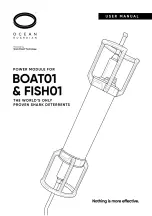
47
47
Section 2 - Rumble Hog Systems
2.12 debris recovery with
Continuous Off-Loading
Trucks equipped with a debris recovery system and
continuous off-loading include a debris tank, vacuum
blower, filter, silencer, 2 cyclonic separators,hoses
and continuous discharge auger in the rear separa-
tor.
The system operates in two modes, continuous
discharge or debris tank recovery. In Continuous
discharge mode, the system creates vacuum in the
cyclonic separators that continuously move debris
from the cutter to the cone shaped separator on the
top of auger. Cyclonic air flow in the cone separates
recovered debris from the air and drops it on the
rotating auger. The auger continuously moves the
debris from the separator to the shoulder or dump
truck. The second cyclonic separator traps debris
that may get past the cone separator to reduce
debris reaching the filter canister.
In debris tank recovery mode, the system creates
vacuum in the debris tank and cutter shroud that
continuously moves debris from the cutter to the
debris tank during operation. Debris accumulates in
the tank which will need to be emptied periodically
during operation.
Optional Debris Recovery System With Continuous Off-Loading System
1.
Cone Shaped Separator & Auger
5.
Hydraulic Hoses
9.
Cyclonic Separator Door
2.
Cone Shaped Separator Door
6.
Vacuum Hose
10. Cyclonic Separator Box
3.
Auger Hydraulic Motor
7.
Vacuum Tube
11. Turret & Lift Cylinder
4.
Vacuum Check Valve
8.
Cyclonic Separator
The following is a description of the major compo-
nents in the system and their function.
Blower And Silencer
The vacuum blower is powered by the hydraulic
system. The truck engine must be set the correct
operating RPM to achieve maximum air flow and
debris recovery.
The blower creates vacuum in the filter canister, cy
-
clonic separators or debris tank, vacuum hoses and
cutter. A filter located in the filter canister protects
the blower. Flexible hoses with quick disconnect
fittings provide vacuum to the separators or debris
tank and cutter shroud.
A relief valves (Kunkle valves) on the debris tank and
near the blower will automatically open if excessive
vacuum in the system occurs when operating in
debris recovery mode. Always test the valves and
all vacuum hose connections at the start of each
shift to ensure the valves are operating properly and
there are no vacuum leaks in the system.
The blower bearing housing is equipped with two
grease fittings that must be lubricated daily to
achieve maximum life expectancy. Refer to the
Lubrication & Maintenance section of this manual
and the blower operation manual for lubrication
specifications.
3
1
9
8
10
11
4
7
5
2
6
Summary of Contents for RH7500
Page 1: ...RH7500 Operations Manual ...
Page 2: ......
Page 6: ...6 NOTES ...
Page 10: ...10 NOTES ...
Page 19: ...19 Section 1 Safety Information ...
Page 20: ...20 NOTES ...
Page 108: ...108 NOTES ...
Page 150: ...150 NOTES ...
Page 155: ...155 Appendix 3 Tools Spare Parts ...
Page 156: ...156 Appendix 3 Tools Spare Parts ...
Page 158: ...158 NOTES ...
Page 163: ......
















































